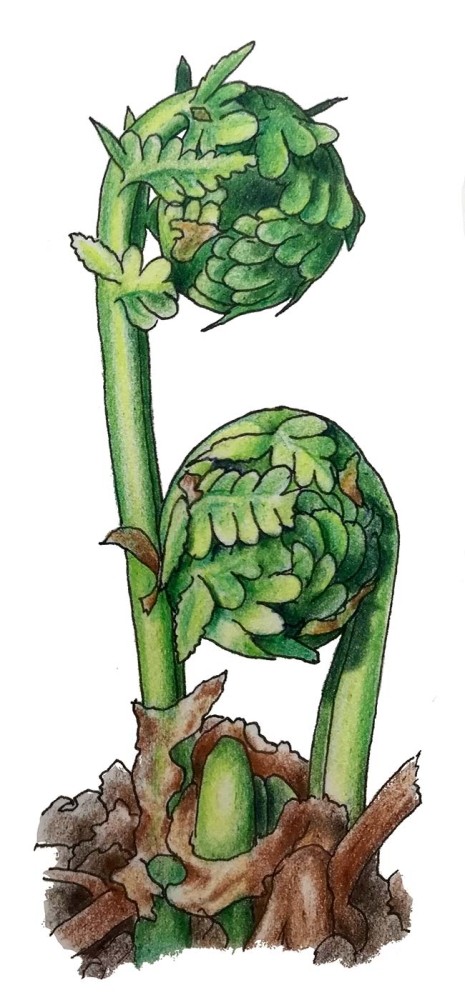Ferns have been around for a mind-boggling 360 million years. That’s more than twice the time that dinosaurs reigned, and more than 1,800 times longer than modern humans have been around. Ferns have weathered four mass extinctions and predated the first blooming flowers by more than 200 million years.
The ostrich fern (Matteuccia struthiopteris) is the only species of fern in our region with edible fiddleheads – the young, unfurled fronds whose leaflets are wound in a tight coil so that they resemble the scrolled head of a violin. Served as a delicacy in posh restaurants, fiddleheads are one of the most widely recognized wild foods. The tender stem of the bracken fern is also edible, but it looks nothing like a fiddlehead.
Ferns grow in all kinds of habitats, from dark forest floors to open pastures, but ostrich ferns are picky about their habitat: they like wet, silty soils. They grow in dense colonies on floodplains and river bottoms. Look for silver maples sinking their roots into a riverbank, and you’ll likely find ostrich ferns, too.
Ostrich ferns are the biggest fern in our area. In summer, they can grow as tall as a person. Their fronds start out narrow at the base and slowly get wider until just before the tip, then taper quickly to a point. Their leaflets are deeply lobed. They grow in a tight clump as if they’ve been placed in a vase. One can see why early naturalists compared them to the decoratively arranged plumes of an ostrich. Each clump usually hosts one shorter, brown, shriveled fertile frond from which the spores emerge.
Fully grown, the ostrich fern is an impressive specimen, but in the early spring when the forager is looking for them, all the previous year’s fronds will have died back. New fronds that the forager wants to harvest are just beginning to emerge. With dozens of other species of ferns, how is one to tell which one is the edible species?
In popular culture (and sometimes even in wild food literature) this seems to be a challenging question to answer. Most ferns are not edible even if they do have fiddleheads. It is disappointingly common for articles about “fiddlehead ferns” to include photos and descriptions of ferns that are incorrectly identified. I’m not sure how this happens as there are several very clear field marks to identify the ostrich fern. First, ostrich fern fiddleheads are not fuzzy. They may have fragments of a brown, papery sheath, but these easily fall away. These are nothing like the clinging, woolly covering of their inedible cousins, the cinnamon and interrupted ferns. Second, the stem of the fiddleheads has a deep, rounded groove that runs the full length of the inside of the stem that is absent in similar looking species. If you’re still unsure, look around the clump for the remains of last season’s distinctive fertile fronds.
Once you’ve identified ostrich fern fiddleheads, harvest is easy. I usually wait until May when the fronds have grown to between 6 and 10 inches tall. With a knife or scissors, I’ll cut one or two fronds from each clump so that the rest of the clump can continue to grow vigorously. Fiddleheads are widely gathered, much more commonly than most other wild foods, so if I see signs that others have harvested from the same population, I’ll leave and harvest somewhere else (see “Sustainable Fiddlehead Harvesting” in Discoveries in the Spring 2021 issue).
As long as the stem isn’t tough, you can use both the coiled part of the fiddlehead and the uncurled portion of the stem. If the bottom parts of the stems are tough, I break off the bottom inch or two by hand just as I would with asparagus. I rinse off the papery scales and steam or fry them. The mild flavor of fiddleheads goes well with all kinds of dishes, from pasta to rice, from soup to pickles, and from soy sauce to basil pesto. There is a reason they are so widely gathered and enjoyed.


